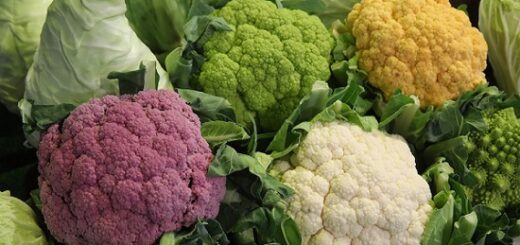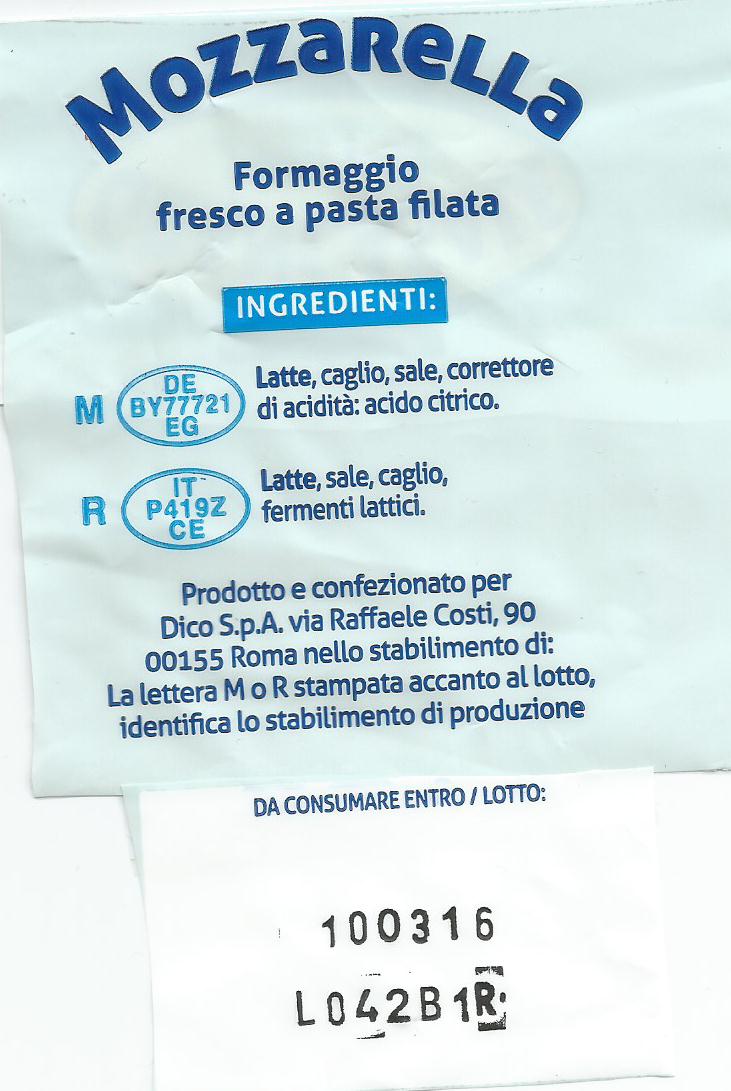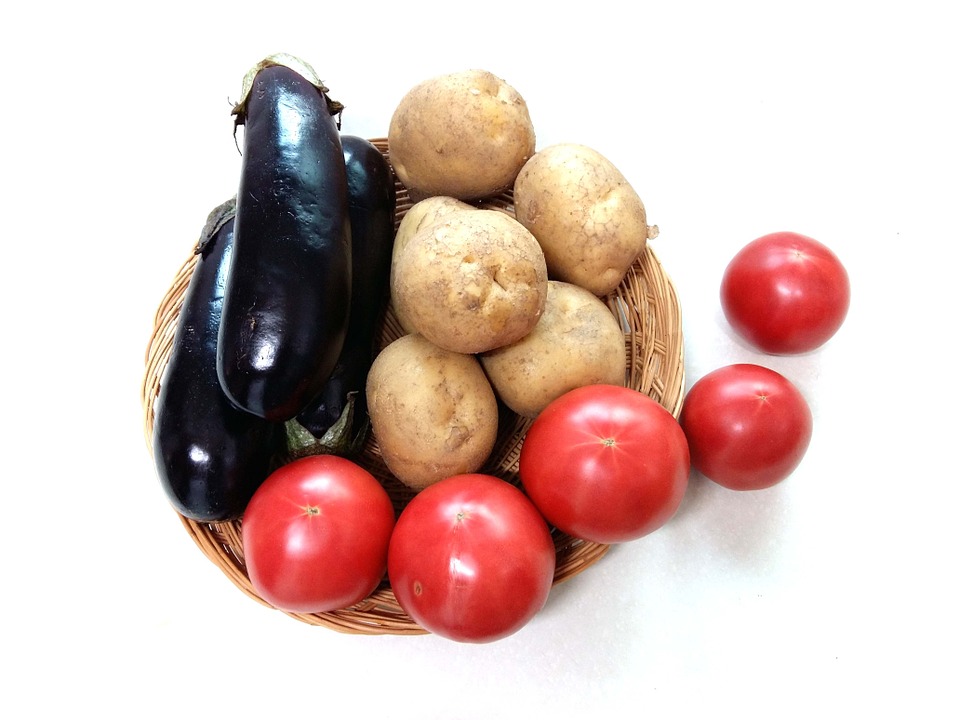Pomodoro, non solo rosso…anche nero
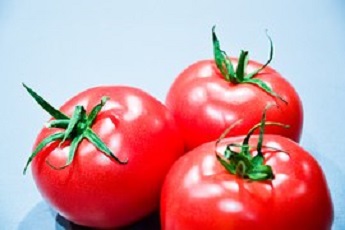
Il pomodoro (Solanum lycopersicum della famiglia delle Solanaceae) è una bacca nativa della zona dell’America centrale, del Sudamerica e della parte meridionale dell’America Settentrionale. La salsa di pomodoro era parte integrante della cucina azteca. I francesi originariamente lo definivano pomme d’amour, “pomo d’amore” per le supposte proprietà afrodisiache.
Introdotto in Europa nel 1540, dal condottiero spagnolo Hernán Cortés, solo nella seconda metà del XVII secolo si ebbe la coltivazione diffusa.
In Italia la prima regione a conoscere la nuova pianta fu la Sicilia per la diretta influenza della Spagna sull’isola.
Fu il botanico senese Pietro Andrea Mattioli che per primo documentò l’ortaggio in Italia nel suo Medici Senensis Commentarii del 1544 dove lo definì mala aurea e tradusse letteralmente in italiano come “pomo d’oro” (per il suo caratteristico colore giallo oro prima dell’ultima fase di maturazione).
La stagione dei pomodori è sicuramente l’estate, anche se oggi, grazie alla coltivazione in serre, è possibile trovarli tutto l’anno. I pomodori hanno solitamente un colore rosso intenso, ma esistono della varietà verdi, gialle e nere. Si, proprio scure, quasi nere; colorazione conferita dalla notevole presenza di antocianine. Questa varietà di pomodoro, nota come Sun Black, non proviene da OGM perché è stata ottenuta dai classici incroci tra semi.
Nel 2009 un consorzio di atenei, costituito dalla Scuola Superiore Sant’Anna di Pisa, la Tuscia di Viterbo e le università di Modena, Reggio Emilia e Pisa, mise in piedi un progetto di ricerca riuscendo ad ottenere un ortaggio che, oltre alle comuni proprietà dei pomodori a buccia rossa, si caratterizzasse per le notevoli proprietà antiossidanti (fondamentali per contrastare l’azione dei radicali liberi), identificandolo col marchio “Sun Black”.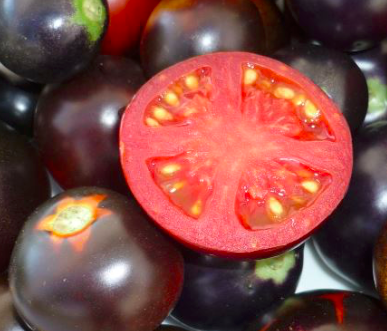
La caratteristica che lo distingue dalle altre piante di pomodoro è la colorazione sempre più violacea, se esposto al sole, mano a mano che avanza nella maturazione, trasformando la sua buccia verde in nera, pur mantenendo rossa la polpa rossa e il gusto intatto.
Per capire quando i SunBlack sono maturi occorre controllare che il colore, nel punto di attaccatura del frutto alla pianta, sotto il calice, viri dal verde ad arancio-rosso.
Il pomodoro, come altri ortaggi appartenenti alle Solanacee (peperone, peperoncino, melanzana, patata), contiene solanina (alcaloide steroidico tossico) che non viene eliminata per mezzo dei normali processi di cottura, ma si riduce quantitativamente col processo di maturazione. 100 gr di pomodoro maturo rosso contengono da 0,03 a 2,3 mg di solanina; il pomodoro giallo-rossastro per insalata ne contiene mediamente 6 mg/100 gr; il pomodoro verde per insalata ne contiene mediamente 9 mg/100 gr; nel frutto verde completamente immaturo il contenuto di solanina può superare i 50 mg/100 gr.
La soglia di assunzione ritenuta sicura sarebbe di 1.5 mg/kg di peso corporeo.
Per la presenza di diverse proteine allergizzanti: (Lyc e 1; Lyc e 2; 2Apoligalatturonasi; alfa-fructofuranosidase; superossido dismutasi; pectinesterasi; chitinosi), il pomodoro può essere causa di allergia alimentare anche grave.
I pomodori hanno solo 18 calorie per 100 grammi; sono fonte di preziosi nutrienti, soprattutto di potassio, fosforo, vitamina C, vitamina K e folati. Il colore rosso dei pomodori è dovuto ad un antiossidante, il licopene, la cui azione è adiuvata da altri due antiossidanti ossia luteina e zeaxantina.
Infine una curiosità: i plurali di pomodoro sono tre; tutti e tre derivanti dal suo essere una parola composta e tutti e tre accettabili.

Quest’opera è distribuita con Licenza Creative Commons Attribuzione – Non commerciale – Condividi allo stesso modo 4.0 Internazionale
English version
Tomato, not only red … also black
The tomato (Solanum lycopersicum of the Solanaceae family) is a berry native to the area of Central America, South America and the southern part of North America. Tomato sauce was an integral part of Aztec cuisine. The French originally called it pomme d’amour, “apple of love” due to its supposed aphrodisiac properties.
Introduced to Europe in 1540 by the Spanish commander Hernán Cortés, widespread cultivation was only achieved in the second half of the 17th century.
In Italy the first region to know the new plant was Sicily due to the direct influence of Spain on the island.
It was the Sienese botanist Pietro Andrea Mattioli who first documented the vegetable in Italy in his Medici Senensis Commentarii of 1544 where he defined it as mala aurea and literally translated into Italian as “golden apple” (due to its characteristic golden yellow color before last stage of maturation).
The tomato season is definitely summer, although today, thanks to cultivation in greenhouses, it is possible to find them all year round. Tomatoes usually have a deep red color, but there are green, yellow and black varieties. Yes, really dark, almost black; colouration given by the notable presence of anthocyanins. This tomato variety, known as Sun Black, does not come from GMOs because it was obtained from the classic crosses between seeds.
In 2009 a consortium of universities, made up of the Scuola Superiore Sant’Anna of Pisa, the Tuscia of Viterbo and the universities of Modena, Reggio Emilia and Pisa, set up a research project managing to obtain a vegetable which, in addition to the common properties of red-skinned tomatoes, was characterized by its remarkable antioxidant properties (essential to counteract the action of free radicals), identifying it with the “Sun Black” brand.
The characteristic that distinguishes it from other tomato plants is the increasingly purplish color, when exposed to the sun, as it progresses in ripening, transforming its green skin into black, while keeping the red pulp red and the taste intact.
To understand when the SunBlacks are ripe it is necessary to check that the color, at the point of attachment of the fruit to the plant, under the glass, changes from green to orange-red.
Tomato, like other vegetables belonging to the Solanaceae (pepper, chilli pepper, eggplant, potato), contains solanine (toxic steroid alkaloid) which is not eliminated by normal cooking processes, but is quantitatively reduced with the ripening process. 100 gr of ripe red tomato contain from 0.03 to 2.3 mg of solanine; the reddish-yellow tomato for salad contains an average of 6 mg / 100 g; the green tomato for salad contains an average of 9 mg / 100 g; in completely immature green fruit the solanine content can exceed 50 mg / 100 gr.
The safe intake threshold would be 1.5 mg / kg of body weight.
Due to the presence of various allergenic proteins: (Lyc and 1; Lyc and 2; 2Apoligalacturonase; alpha-fructofuranosidase; superoxide dismutase; pectinesterase; chitinosis), tomatoes can cause even severe food allergy.
Tomatoes have only 18 calories per 100 grams; they are a source of valuable nutrients, especially potassium, phosphorus, vitamin C, vitamin K and folate. The red color of tomatoes is due to an antioxidant, lycopene, whose action is supported by two other antioxidants, namely lutein and zeaxanthin.



